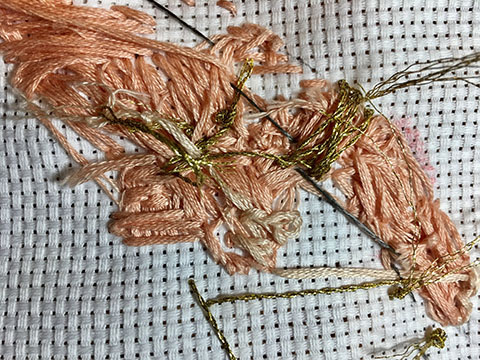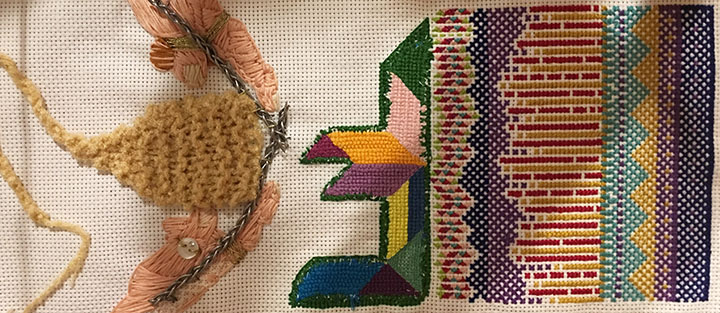Storing & Indexing Data: Possibilities for Material Data Structures
Data visualization is a made object. Maria Novotny (2015) argued that the made object is the tracing of the body of the person who made it, and, in that, is a memorial, a way of communing with someone (or something) gone. Although textile makers—not only fiber workers, but researchers, historians, and communicators—might be gone or far away, their textiles store their bodies and experiences for us to retrieve and recover. In the cross-stitched and knitted samples we produced together over a series of several weeks, the fiber we used and the methods we employed have gathered people, situations, histories, and sensory materials as data: the hands, space, imagined homelands, longings, minds, nursing homes, and so on.
Textiles store, index, and arrange in meaningful ways a variety of information that allow us to call up and access data from far away and long ago.
The production of textiles is a physical act of weaving data that is visible and material. The materials and feelings that take part in the making of an object are that object, constructing a larger picture of the meaning-making that has occurred. In producing textile work, we collect all kinds of material and affective data and transfer it both literally and figuratively to the fabric. In the piece featured in Figure 1, Krystin accidentally stitched pieces of hair as well as pet hair into the fabric, imbuing it with bodily materials. She spilled a drop of wine and a drop of coffee while stitching in the evening. Krystin licked the ends of threads to smooth them, thus weaving in and intermingling pieces of genetic material. She made mistakes, stitched with too much tension, or used the wrong color and chose not to tear it out. These accidents are also traces of learning, of grappling with materials and environments, that became woven into the piece in material and visual ways.

The sense, emotion, and material data collected through making are stored in the textile that has been produced. As in Angela Haas’s (2007) discussion of wampum as hypertext, these textiles are sign technologies encoded with meaning, matter, and experience. They are made from the interrelation between materials and contain nodes and links that index information in an associative mesh. As we have collected data, we have also stored it in a momentarily stable form, namely the fabric itself. Although stains and spit may have been washed away or evaporated, their traces are still there. The textile we've produced stores a collective memory between us and serves as an interactive user interface.
When we access a piece of stitched cloth—when we hold it, use it, wrap it around us—we call upon these data, even if unintentionally or unknowingly.

We conclude with a final possibility for understanding made things, and in particular textiles, as data materializations. In using software to create data visualizations, there are at least two steps that are separated from one another: the collection of data and the analysis of data. Often, there is even one further step, that of cleaning one's data so that it might fit the protocols of a visualization software. But in the production of textiles and of made things more generally, we see these two processes simultaneously at work rather than abstracted from one another. Making things collapses the separation between gathering the world and understanding the world. It is both, simultaneously. While we collect our materials, sensations, feelings, and situated environments, we are also actively understanding it through the act of gathering.
What might this mean for composition and rhetoric scholars? We hope that with a broader lens, our field might begin to understand data as something more than what is visualized with electronic means, a practice that comes steeped in histories of technology, privilege, and erasure. We hope this feeds into our understandings of knowledge production, both in our scholarship and in our classrooms. What gatherings do we find ourselves doing to understand patterns and experiences? And as educators, what are our students collecting and making, and by doing so, visualizing and making material to demonstrate their place in the world?